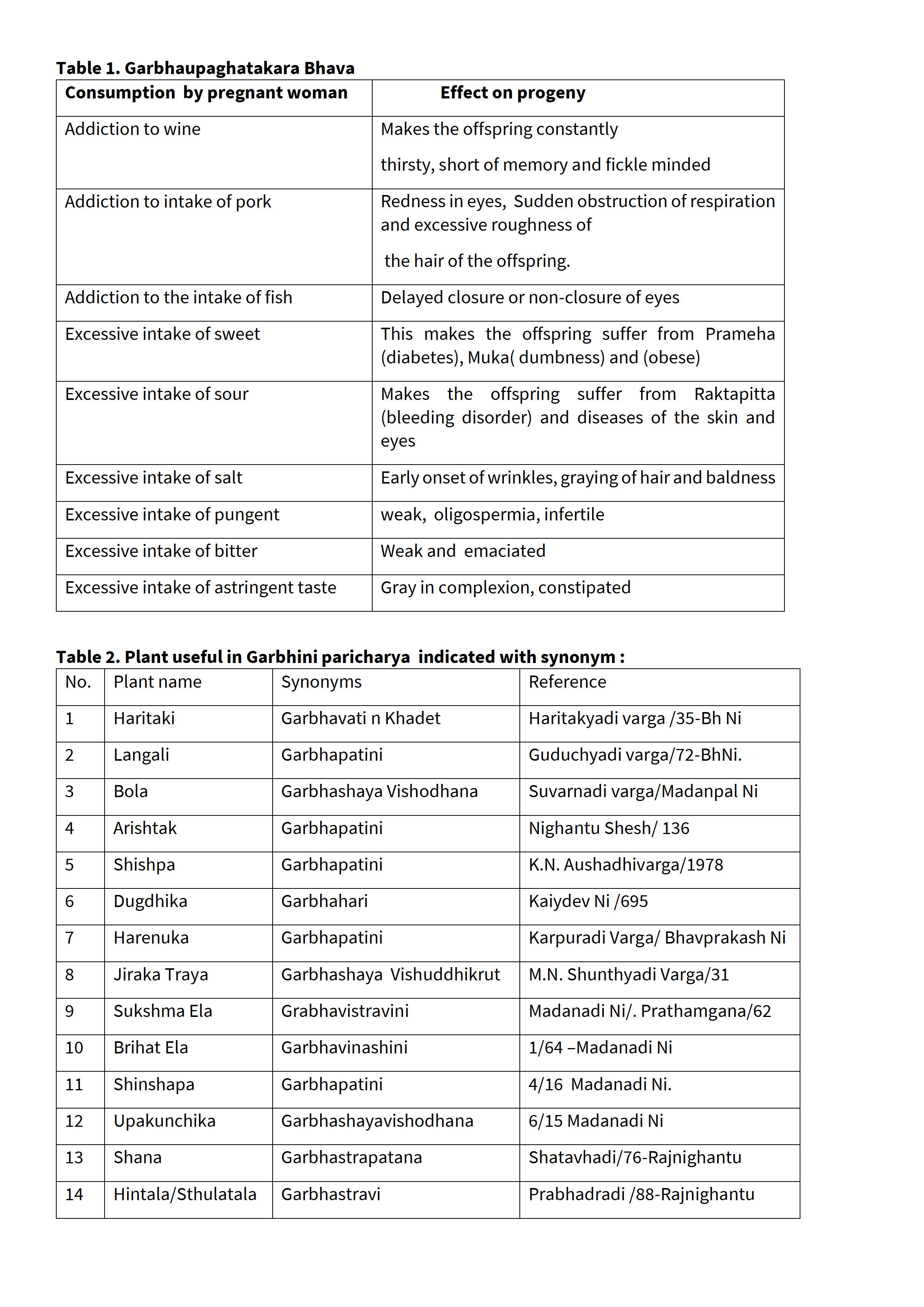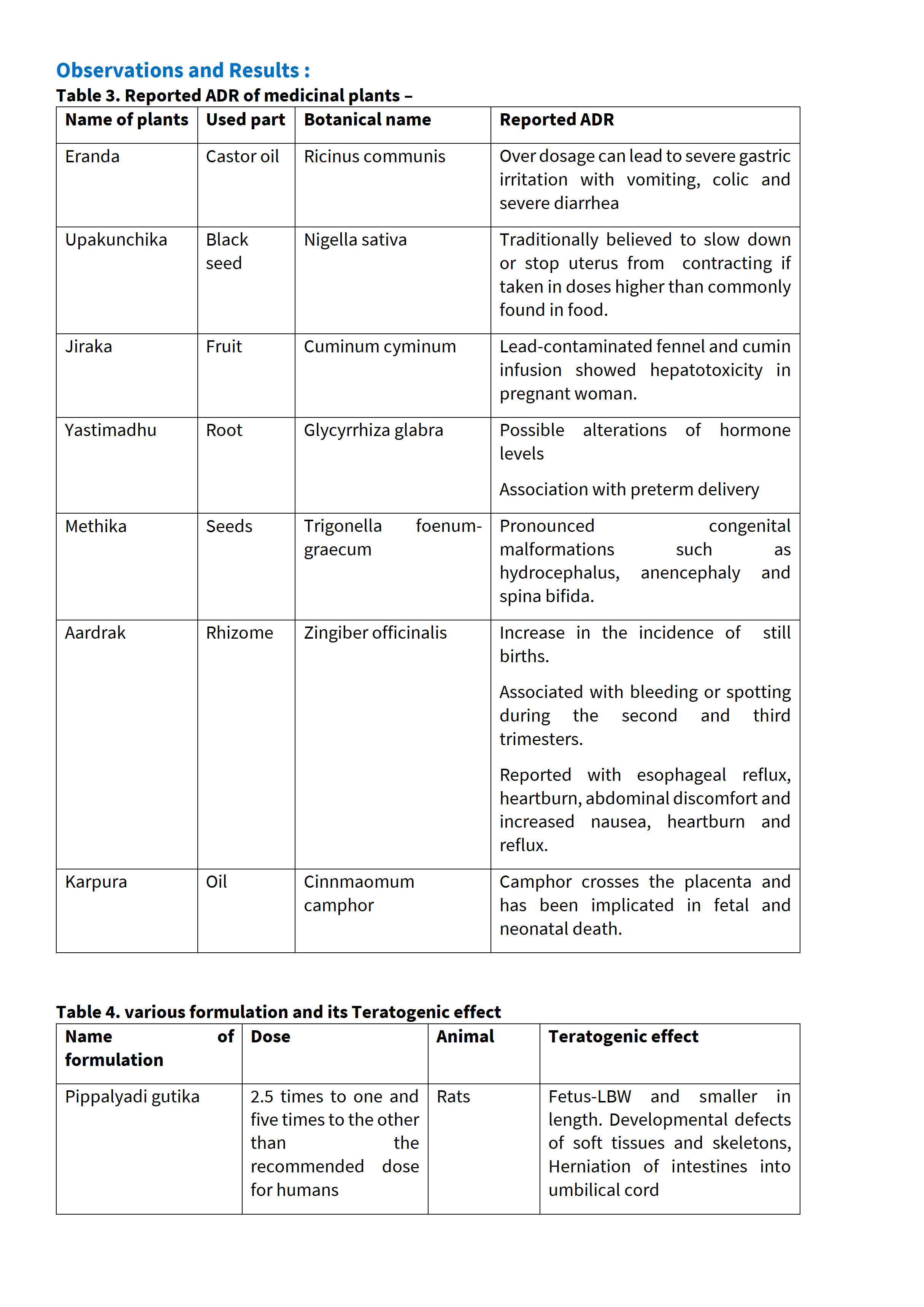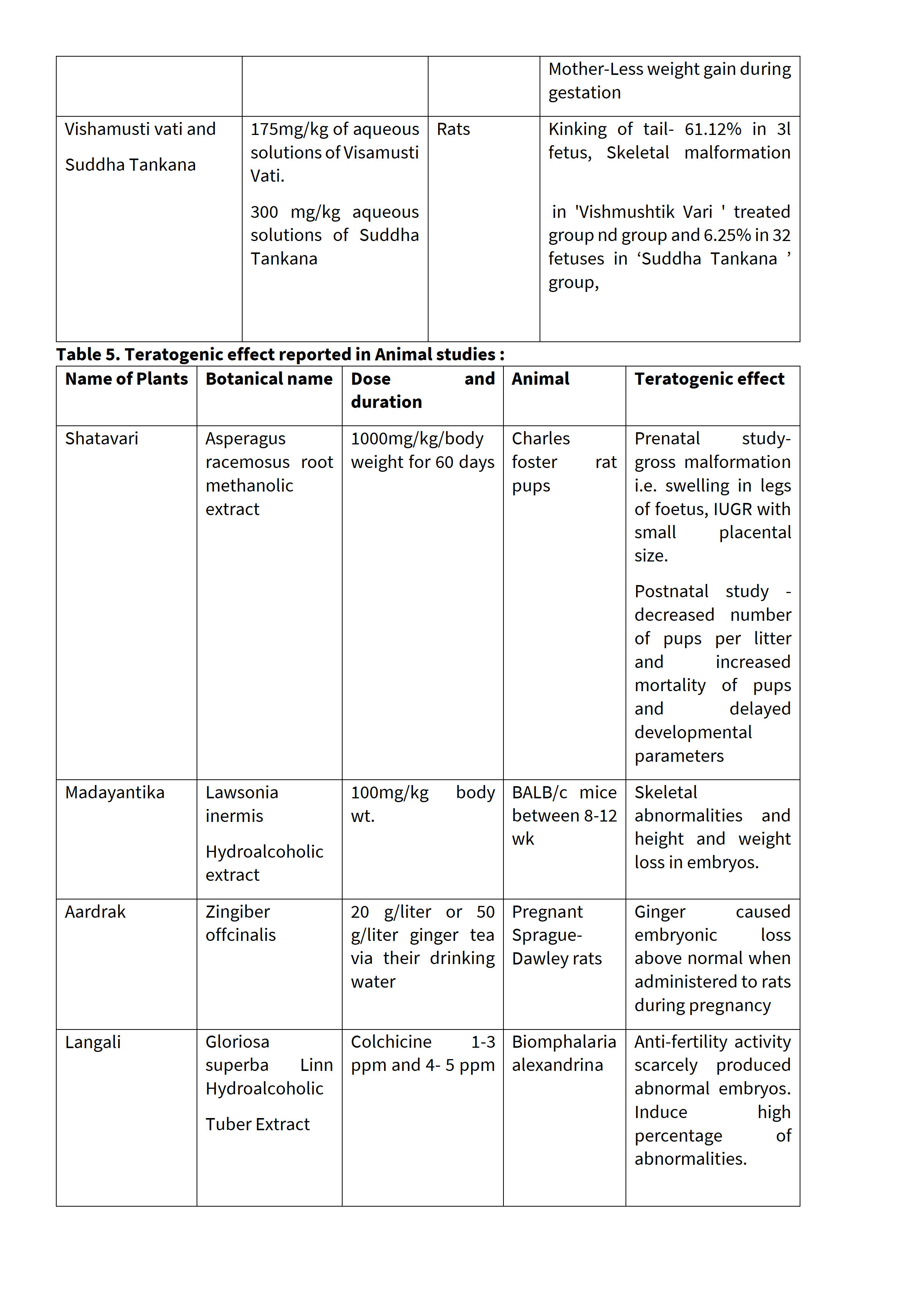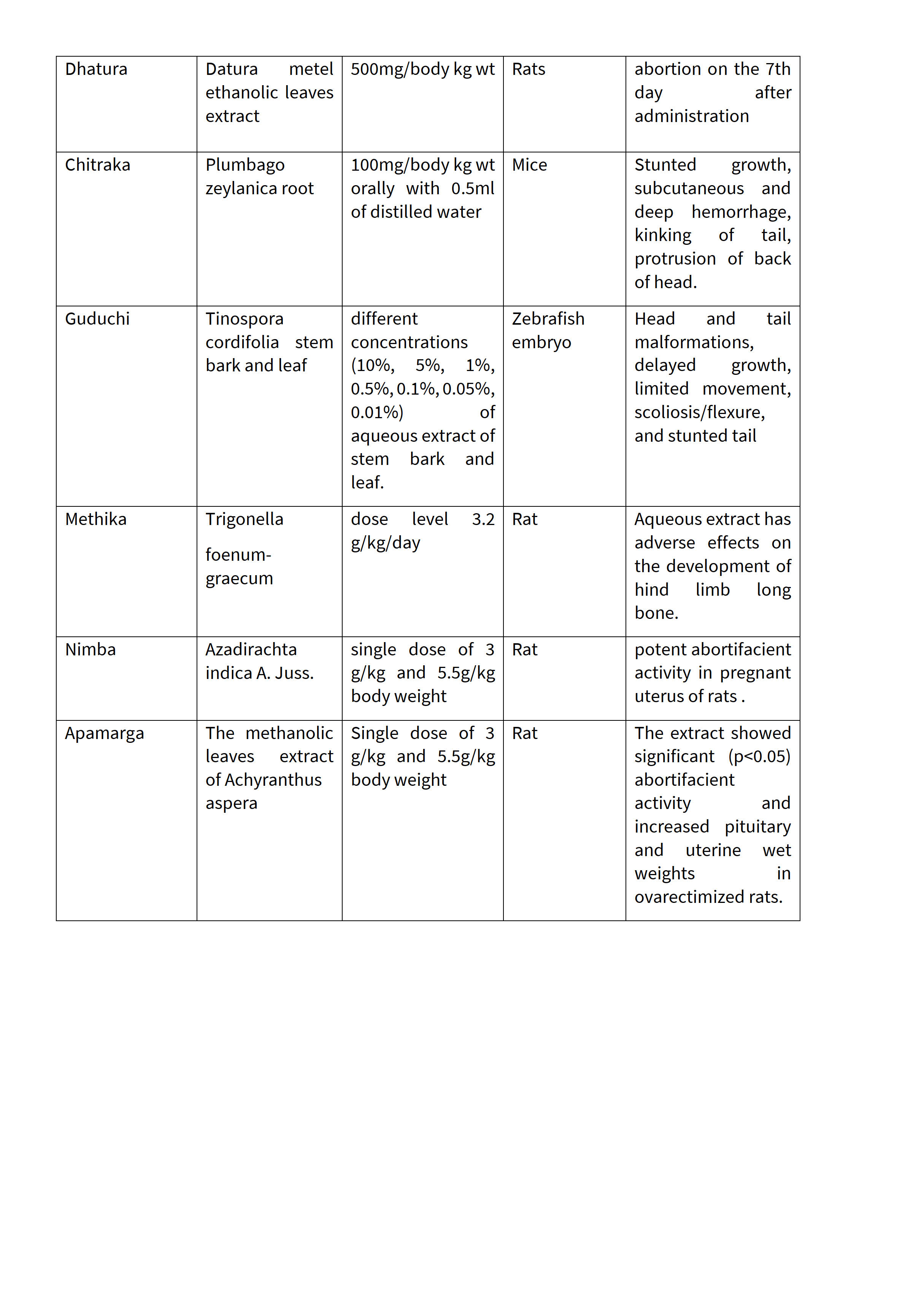Review Article
Year: 2021 |Volume: 2 | Issue: 05 |Pages: 33-41
Perspective of Ayurveda on use of medicinal plants to avoid possible risk in Garbhini
About Author
Correspondence Address:
Dr Vishnu Bawane Professor & HOD, Dept.of Prasutitantra-Strirog, B.R.Harne Ayurvedic Medical College, Vangani, Thane.(INDIA) Email: drvcbawane@gmail.com Mobile No. 93247 37097
Date of Acceptance: 2021-05-11
Date of Publication:2021-06-05
Article-ID:IJIM_75_06_21 http://ijim.co.in
Source of Support: NIL
Conflict of Interest: NIL
How To Cite This Article: Bawane Vishnu,Kolhe Rasika. Perspective of Ayurveda on use of medicinal plants to avoid possible risk in Garbhini. Int. J Ind. Med. 2021;2(5):33-41
Abstract
Prevention is better than cure’ is the basic concept of Ayurveda. Curing a diseased person and redefining healthy status, is the primary goal of a physician. Pregnancy is an important phase in women’s life. Health of the pregnant women has a major role in reducing adverse pregnancy outcomes. Ayurveda is the science of life; which helps to provide proper health with the help of some rules and principles. Women plays very important role in every one’s life. In Ayurveda various preventions are described for a pregnant woman. Like different Paricharya’s are explained for the better health during pregnancy, and for avoiding complications or risk developed during or after pregnancy. Its implementation helps to provide good health for women as well for child. If any complications or risk forms during pregnancy there are various medicinal herbs or treatments are present for this. With the help of medicinal herbs, we tried to avoid different complications or risk factors in Garbhini.
Keywords: Garbhini, Medicinal herbs, paricharya, swasthya.
Introduction
Ayurveda is a science of life, basic principle of Ayurveda ‘swasthya rakshanam athurasya roga prasamanam.’[1] To maintain Swasthya of pregnant women ‘Parichaya’ is most important. Garbhini Avastha is one of the precious stages of any woman’s life. Ayurveda offers code of conduct to be followed right from the Rajaswala (menustruation) to Sutika ( Post partum). [2] Do’s and don’ts are mentioned directly or through fundamental principle. Prevalence of herbal drugs use in pregnant woman is very common. But nowadays many cases of ADR(Adverse drug reaction)are reported on use of Ayurvedic products and medicinal plants. Ayurveda, the science of life has given much importance to woman’s health, as she is the root of the progeny. The care of the pregnant and the new born are well explained in various Samhitas. [3] Regimen to be followed during antenatal and post natal period for the optimal health of mother and child is highlighted. Antenatal care is the care of women during pregnancy period. The aim of ante natal care is to reduce the risk of still births and pregnancy complications and to have a positive pregnancy experience & outcome. Masanumasika Pathya or month wise dietary regimen and Garbhopaghatakara Bhavas (diet and activities harmful to the fetus) are elaborated in all major texts.[3]
Objectives:
- To study the perspective of Ayurveda on use of medicinal plants in Garbhini.
- To compile and critical analyse the information and data regarding use of medicinal plants and their safety in pregnancy.
Material and Method :
Medicinal plants reported with possible risk in Garbhini or contraindicated in Garbhini have been compiled from e-Nighantu. Certain fundamental principle elucidating the safety aspect of Garbhini and Sutika are also compiled and analysed. Reported data on ADR in pregnancy have been critically analysed and presented systematically.
Essential for Pregnancy :
In Ayurveda there are four essential things for development of pregnancy includes ; Most appropriate season ( Time ), Nutrition from mother, Healthy uterus and other reproductive organs, good quality ovum and sperm. All this factors can be achieved by; Detoxification and purification by means of Panchakarma.[4] Rasayana and Vajeekarana(Virilizing herbs like -Shatavari, Ashoka, Ashwagandha and Kapikachhu) and foods.[5] Ayurvedic texts say a pregnant woman is to be treated as delicately as if one is carrying a pot full to the brim with oil, without spilling a drop. Pregnant woman should eat cooked, liquid, warm, fresh food containing all six tastes of sweet, sour, salty, bitter, pungent and astringent in the right proportion. In order to support each developmental phase of the baby, Ayurvedic doctors advised certain herbs and foods to be taken each month of pregnancy. This regime is named as “Masanumasik Paricharya of Garbhini”. It is Month-by-month diet and Medicinal Regimes for good, complete growth and development of the baby. [6]
Effect of Diet in Pregnancy : Aahara or diet is very important in every one’s life. It is an Prana of human as per Ayurveda. It helps us to provide good health if we consume good diet with proper amount. In Ayurveda the amount of Aahara is also important aspect. On our health Aahara, Vihaara and Manasa bhavas are plays important role. Because their effect leads to Agnimandya which further develops various diseases.Acharya Charaka described that various Manasa bhavas leads to disease formation and its effect may develops various risk factors or complications. Manasa abhitapa, Krodha, Shoka, Bhaya, Shrama, Ushna annapana causes various hazards effects on Garbhini. So proper diet with peaceful, happy mind is also a way for healthy life.[7]
Garbhaupaghatakara Bhava :There are various Garbhaupaghatakara Bhavas which leads to various difficulties to developing Garbha. It can be Aahara, Vihara or any factor which are responsible for development of risk factors for women and child.[9]

Table 1

Table 2

Table 3

Table 4
Pregnant women should avoid ; -
- Kshara,(Alkali)
- Katu( Pungent)
- Amla( Sour)
- Tikshana(Sharp/penetrating)
- Ushna( Hot potency)
- Ruksha( Dry)
- Vidahi ( causing burning sensation during digestion)
- Sauviraka,( Alcohol)
- Palandu( onion)
- Kanda( Tubers)
- Tila (sesame)
- Masha( black gram)
- Surana(yam)
Apathya Ahara (unwholesome food)
Pharmacovigilance: No drug which is pharmacologically effective is entirely without hazard. The hazard may be insignificant or may be acceptable in relation to the drug's therapeutic action. Furthermore, not all hazards can be known before a drug is marketed.
Ayurvedic Pharmacology :A potent poison becomes the best drug on proper administration. On the contrary, even the best becomes a potent poison if used incorrectly.
Discussion
Little information about the possible risks in pregnancy on use of medicinal plants is reported. Ayurveda advice diet, regime, routine to be followed to take optimum care of pregnant woman and healthy progeny. Medicinal plants having possible risk in pregnant woman are clearly mentioned in the Ayurveda.[10] Medicine in optimum dose and duration, following the fundamental principle, do not cause Teratogenic effect. Ethnobotanical study should be conducted to record the medicinal plants and regime during the pregnancy used by the elders, folk healers, dai etc. There is need to conduct Robust studies to identify adverse events or herb–drug interactions and associated adverse events arising during pregnancy and the postnatal period as a primary objective. Reporting of ADR and its Causative assessment is essential. Knowledge and awareness about use of medicinal plant during pregnancy is required to avoid possible ADR.
Conclusion
Use of medicinal plant and traditional system is prevalent among pregnant women worldwide. Certain medicinal plants are reported with contraindication in pregnancy. Few drugs are also reported with ADR. To create awareness about prevention of possible adverse effects during pregnancy or the postnatal period , it is essential to understand fundamental principle of Ayurveda, Code of conduct and Garbhopaghatakar Bhav depicted in classical text. Scientific validation on safety of use of medicinal plants in pregnancy and exploration of ADR if recorded, is need of hour.
References
- Reddy Sudhaka. Comprehensive guide to Swasthvritta. Varanasi, Chaukhamba Sanskrit Pratishthan,2006, p.114
- Dr. Ajinkya Gite. Ayurvedic Approach of Garbhini Paricharya (Regimen For Pregnant Women. Int. J. Adv. Res. 7(6), 883-887
- Aacharya Yadhavji Trikamji, Charak Samhita (978-81-7637-133-9) of Agnivesa, Chakrapani Datta’s Ayurveda deepika (sans), Reprint edition 2015 Sharirasthan, Srotasam vimana 5/3,Chaukhambha Sanskrit Series office,Varanasi, 2015, pp 346
- Rasmi Hadimani & SheelaMallikarjun: Concept Of Garbhini Paricharya: A Scientific Review. International Ayurvedic Medical Journal ;2018 ,6(6)p1276-1282.
- Sharma PV. Dravyaguna vignan (Vol-2) Reprint Ed. Varanasi; Chaukambha Bharati Academy;2005. P.148,632.
- Tiwari P V. Ayurvediya Prasutitantra evum Striroga Part 1, 2nd Edition, Varanasi, Chaukhamba Oriental, 2009, p. 242-243.
- Chakrapani , Charaka Samhita by Agnivesa, edited by Vaidya Jadavaji Trikamji Acharya, Sutrasthana, adhyaya 30th , Shlok no. 26, Chaukhambha Publications, New Delhi, Reprint 2017, 187.
- Shashri S, Pandey K. Chaturvedi G. Charak Samhita of Agnivesha, Revised by Charak and Dridhabala, Elaborated with Hindi commenraty , Sharirstahna, Chapter no 8, Verse no 33, Varanasi, Chaukhamba Bharti Acadamy, 2007, p. 939.
- Dr. Bhaskar Govind Ghanekar,Sushruta Samhita, Sharirasthan, Reprint ed 2013, Meharchand Lachimdas Publication, New Delhi (Vol 3); pp 246
- Dr. Meghna P P, et al, A critical review of Garbhini Ksheerpakas mentioned in Ayurvedic texts of Kerala, JAIMS, May-June 2019, 4( 3) page no.1.
"

